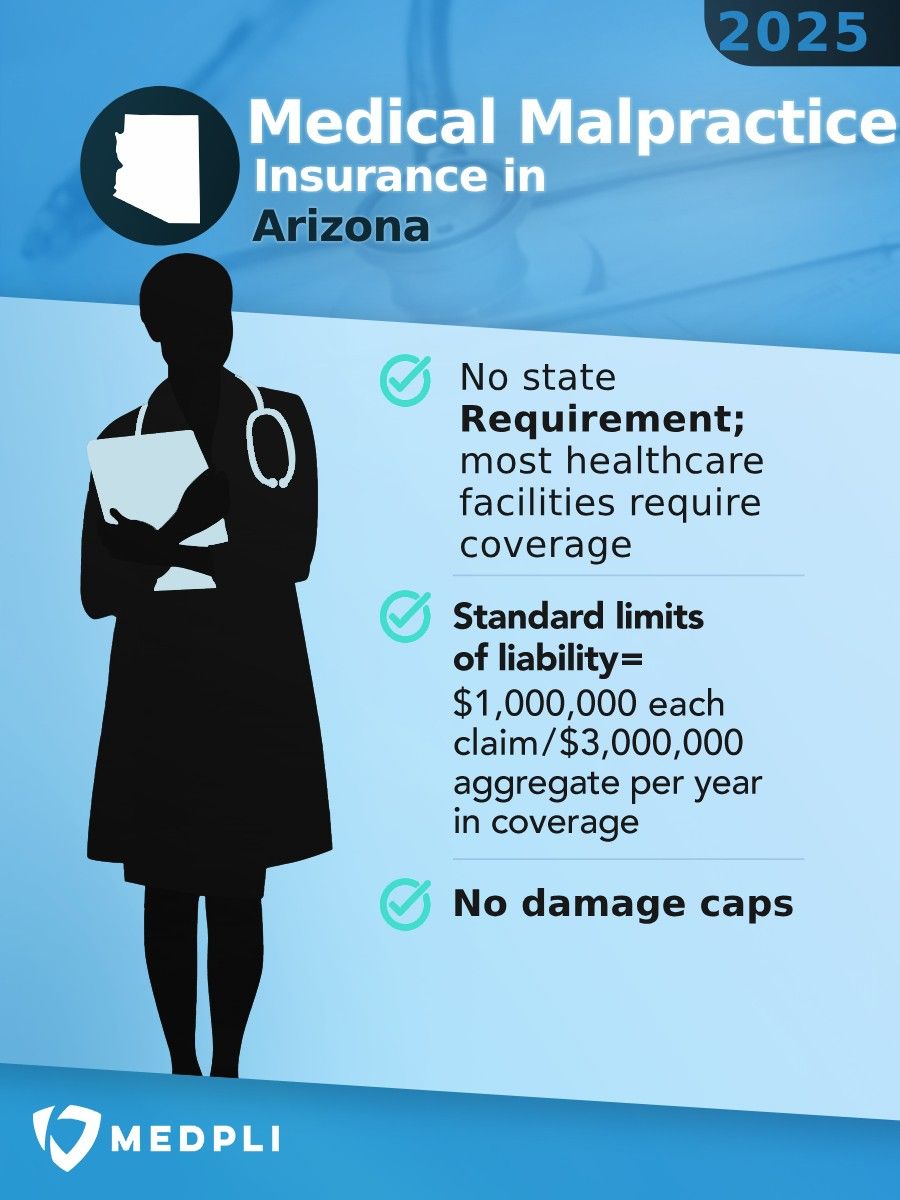Top 5 Malpractice Insurance Carriers in Arizona
We recommend carriers with an AM Best “A” or higher rating. An A-rating indicates financial strength, long-term solvency, and an established history of protecting Arizona physicians.

2025 Arizona Malpractice Insurance Rates by Specialty
These rate estimates are for informational purposes only and are based on the AZ standard limits of $1,000,000 for Each Claim / $3,000,000 Aggregate per year in coverage.
Quotes require a completed application and underwriter approval. Contact us for a custom estimate if you don’t see your specialty.
| Specialty | 2025 Annual Premium |
2025 Tail Premium |
|---|---|---|
| Anesthesiology | $20,000 | $40,000 |
| Cardiovascular Disease– Minor Surgery | $22,000 | $44,000 |
| Dermatology– No Surgery | $12,000 | $24,000 |
| Emergency Medicine | $28,000 | $56,000 |
| Family Practice– No Surgery | $14,000 | $28,000 |
| Gastroenterology– No Surgery | $15,000 | $30,000 |
| General Practice– No Surgery | $15,000 | $30,000 |
| General Surgery | $48,000 | $96,000 |
| Internal Medicine– No Surgery | $15,000 | $30,000 |
| Neurology– No Surgery | $17,000 | $34,000 |
| Obstetrics and Gynecology– Major Surgery | $70,000 | $140,000 |
| Occupational Medicine | $10,000 | $20,000 |
| Ophthalmology– No Surgery | $9,000 | $18,000 |
| Orthopedic Surgery– No Spine | $39,000 | $78,000 |
| Pathology– No Surgery | $11,000 | $22,000 |
| Pediatrics– No Surgery | $14,000 | $28,000 |
| Pulmonary Disease– No Surgery | $18,000 | $36,000 |
| Psychiatry | $9,000 | $18,000 |
| Radiology – Diagnostic | $20,000 | $40,000 |
Have a question? Get fast answers from a U.S.-based MEDPLI agent. Call 1-800-969-1339 or email info@medpli.com.
Arizona Medical Malpractice Payouts From 2015-2023
Types of Professional Liability Insurance for Arizona Physicians
Physicians in Arizona can choose between these two primary types of medical malpractice insurance:

- Provides coverage for incidents that occurred during the policy period IF the claim is filed while the policy is still active. If a claim is filed after the policy ends, that claim is NOT covered.
- Typically, it offers lower premiums at the start of the policy, but rates increase yearly as the policy matures.
- Physicians need to obtain tail insurance coverage when a claims-made policy ends to ensure protection against future claims related to incidents that occurred during the policy period. Tail insurance premiums require a one-time cash payment equal to approximately 200% of the claims-made policy annual premium.

- Provides coverage for incidents that occurred during the policy period, regardless of when a claim is reported to the carrier.
- Typically, it offers more costly premiums at the start of the policy, but the rate stays constant for the entire policy length.
- Physicians do not need tail coverage when an occurrence policy ends.
In 2023, Arizona physicians were held liable for 98 medical malpractice payouts.
- Average Payout: $440,607
- Total Payout: $43,179,500
(Source: National Practitioner Data Bank)
Does Arizona Have Damage Caps for Medical Malpractice Lawsuits?
Non-economic or economic damage caps for medical malpractice lawsuits are considered unconstitutional in Arizona per Article 2, § 31 of the Arizona Constitution, which prohibits limitations on damages for personal injury or death.
Arizona Statute of Limitations for Medical Malpractice Claims
Under Arizona law, an action for medical malpractice damages shall be filed within:
- 2 years from the date of the alleged injury, or
- 2 years from when the alleged injury is discovered.
Exceptions to the limitations include:
- Intentional concealment
- Proof of fraud
- Cases involving a plaintiff with a mental disability
- For minors, the two-year limit begins on their 18th birthday
Why Arizona Doctors Partner with MEDPLI
We exclusively broker medical malpractice insurance, focusing daily on making the professional liability process less burdensome and expensive for doctors.
With MEDPLI, Arizona physicians:
MEDPLI helps doctors in every specialty.
Whether you’re an orthopedic surgeon in Phoenix or a dermatologist in Tucson, MEDPLI will find you premier coverage at a competitive rate. Call 800-969-1339 or Request a Quote.






